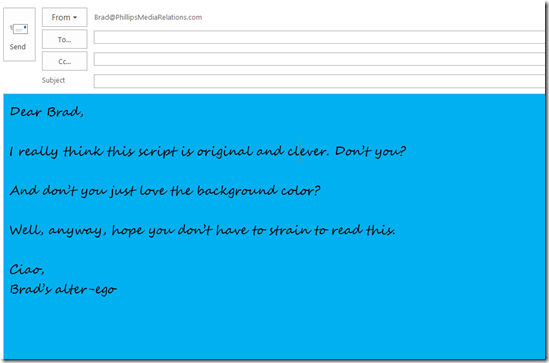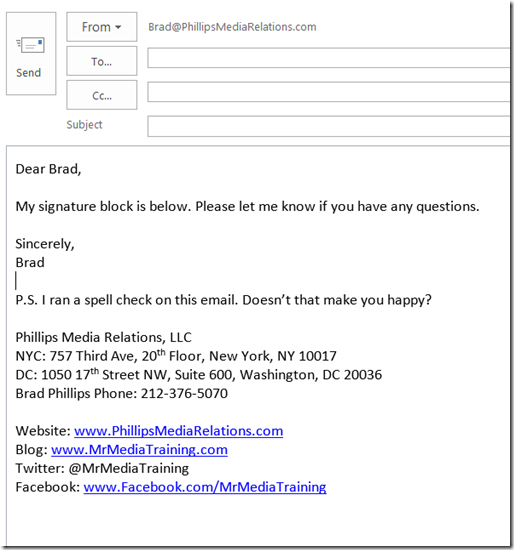Seven Tips For Better Business Email Etiquette
I recently received an email from a reader who asked for some advice on email etiquette.
At first, I thought that topic would be too far afield for this blog. But the more I thought about it, the more I realized that email etiquette is relevant for a media training blog, since the etiquette one uses when communicating with reporters (and others) can help form a positive impression—or not.
Still, this topic is a bit outside of my day-to-day expertise. Therefore, I’m going to offer several tips on the topic, but would ask you to add your own suggestions in the comments section.
1. Don’t Use A Busy Template
My biggest pet peeve is the type of background below. To make these templates even more difficult to read, some people use a patterned background, occasionally with a ribbon extending down the left or right margin for additional adornment.
I appreciate the attempt at originality, but just like with PowerPoint, just because the features allow you to do this doesn’t mean you should.
2. Run Spell Check
I’m forgiving if someone accidentally uses “your” instead of “you’re,” or something similar. Both are actual words, and a spell check program could miss their intended usage. But there’s just no excuse for not running a spell check on your emails before clicking send. Emails with numerous spelling errors send one message: “I’m unprofessional.”
3. Maintain The Right Level of Formality
I’m not going to bemoan our social media era, in which many people type texts and IMs without capitalizing the first letter of a sentence, fail to use proper punctuation, etc. Sending an IM to a buddy doesn’t require much formality, and it’s up to your peer set to decide what style works best. But bringing those same traits to a professional setting sends the wrong message, as they doesn’t match the requisite level of formality.
As an example, if someone I’m familiar with doesn’t begin an email with “Hi Brad” or “Dear Brad,” that’s fine—it’s okay to jump right in if we’ve already established a relationship. But a stranger who makes their first contact with me by just beginning to talk without a greeting? Well, that just doesn’t make a great first impression.
4. Get To The Point
The Radicati Group, a technology market research firm, estimates that business end users send and receive an estimated 126 emails per day. That’s on top of the messages they receive through social media, phone calls, and snail mail. It’s a good idea to be mindful of that when sending emails to another party. When reviewing your email before you send it, ask yourself this question: “This person will read or send 125 other emails today. Am I respecting this person’s time by making my point clear, simplifying the communication, and removing unnecessary content?”
5. Include a Signature Line
When I want to call people, follow them on Twitter, or mail something to them, one of the first places I look is to the signature section at the bottom of their email. Surprisingly, many people don’t include one. I personally include my email signature in every new email and when responding to someone for the first time in every new email chain.
6. Use Your Professional Email Address
Use your professional email address when sending work-related emails [Insert your Hillary Clinton joke here]. It could send an unintentional message when you use a Gmail or Yahoo account in a professional setting. In my case, I sometimes wonder, “If this person is the vice president of operations for their company and wants media training, why are they using an AOL account? Is he pursuing the training independent of his company? Does he not want his company to know? Is he really who he says he is?”
7. Decide Whether Email Is The Best Format
I recently received an email from a professional partner that contained some upsetting news. I kept typing back a response, deleting it, starting over again, and deleting it again. Everything I typed sounded more aggressive than I intended it to, and I was struggling with finding the right words. Then I realized why: This conversation would be better for both parties if it was conducted as a phone call rather than through email. Before clicking “send,” ask yourself whether the medium itself is ideal for your message. Sometimes, the best email etiquette means knowing when not to send one at all.
What tips would you add? Please leave your thoughts in the comments section below.



Don’t blind copy others into private personal or business correspondence, especially if it has nothing to do with them.
Hi Monica,
Yes, good one! I’m glad Outlook finally has the feature to “mute” conversations that you shouldn’t have been a part of in the first place.
Thanks for adding your tip.
Best,
Brad
I would add – if you have to answer : ok, received, will do, or something like that , dont copy everyone who is copied in the original email.
Imma,
Yes, I agree.
One similar pet peeve of mine is when the exchange is over, has been officially concluded, and the person writes back with a smiley face or something of the like. Every “ding” from a new email is potentially distracting and has to be deleted from my computer and smartphone. It’s not a big deal, but it is an unnecessary waste of several seconds.
And don’t get me going on using numerous emoticons in business communication…
Brad
This is a great list. Agreed on all points. Number 3 on formality is a big one. Some type an email as if they are texting. Some feel they know you well enough to start the email with a Hey John,… I look forward to your posts. Keep them going!
Dear Mr Phillips,
I agree with the other posters – I find it always best to err on the side of being formal. One will rarely be chastised for this approach.
With my mobile phone (SMSes), when dealing with clients, I also use a formal tone and a templated signature block e.g.
Dear Ms. XXXX,
Thank you for your call. I will be onsite at your property to supervise the safety inspection at the agreed time today. Please call me if you have any questions.
Kind regards,
Roger XXXX
Service Rep
XYZ Safety
555-1234
info@xzysafety.com
visit us at: http://www.xyzsafety.com
download our mobile app here: XYZ SAFETY
I find this errs on the side of formality with some of our elderly clients who prefer the older days of formal etiquette. It also allows younger, tech-savvy clients to email me using these details (most smartphones in this day and age allow an instant email service to be opened up when the email address is “hovered over”). Also having the APP link has been known to drive more business my way (at least in my industry) due to our clients and service providers being predominantly mobile. Not everyone executes business from behind a desk.
While initially surprising, I am now used to receiving business referrals from “blue collar” trade staff who may not have email set up on their phone (whilst on the road or out of cellular data range), yet were “forwarded” an SMS from another client etc with my signature block ready for contacting. You never know WHO will be reading your message and these extra contact details can mean the difference between winning new business…or not. I find that trades staff (the bulk of my business) usually read their work emails late at night yet heavily operate on SMS during business hours.
Kind regards,
Roger
Brad
A small point: consider “commit to omit” the commas after the greeting and salutation. “Open punctuation” is an accepted style and just think of the effort saved if tens of millions drop all those unnecessary commas.
John
To expand on your #7: I have found that many people are email bullies. They would never say on the phone, and certainly not in person, what they just said in an email. Sometimes it’s best to let the message sit in “draft” for a few hours before sending.
Linda
Good article, Brad.
I wish people would read, consider, and formulate a response to an email before just reacting viscerally and responding quickly. I used to work for a law firm in Chicago. The mossy crone who runs the joint required all his employees to send a quick email response to all emails they received.
He followed this practice himself, to his detriment. After I left the firm, this egregarious fellow continued to send me work to do. I sent him an email explaining what I thought he knew – that I no longer worked for him; I explained what he could do to accomplish the task at hand.
Well, rather than his doing what I suggested, he immediately sent me an angry, defensive email. I didn’t and won’t respond to an email which just shows his ignorance. I haven’t done any more free work for him, including giving him any more much-needed advice. His complete unprofessionalism cost him dearly.
Working as a public relations assistant in a center for gerontology, and as a college student, I receive the most traditional, formal emails from clients. I cannot stress to my coworkers how important it is for them to reply in the same manner. I find that individuals my age are leaning towards the “texting lingo” and assuming that our contacts understand what they are saying, when they actually have no indication of what they are trying to communicate.
I also find that following these guidelines aids to my success in the classroom. When emailing professors in a polite and formal manner, avoiding typing errors, adding a signature, etc, I always find that my professors are more willing to communicate with me in a timely manner.
Great article, Brad!
I would add – Do not abuse Reply All. I have been a part of monster threads from clients that were about planning a happy hour… which were funny at first then quickly turned into an annoyance because I constantly had 30 unread emails. Isn’t this why Slack was invented?!